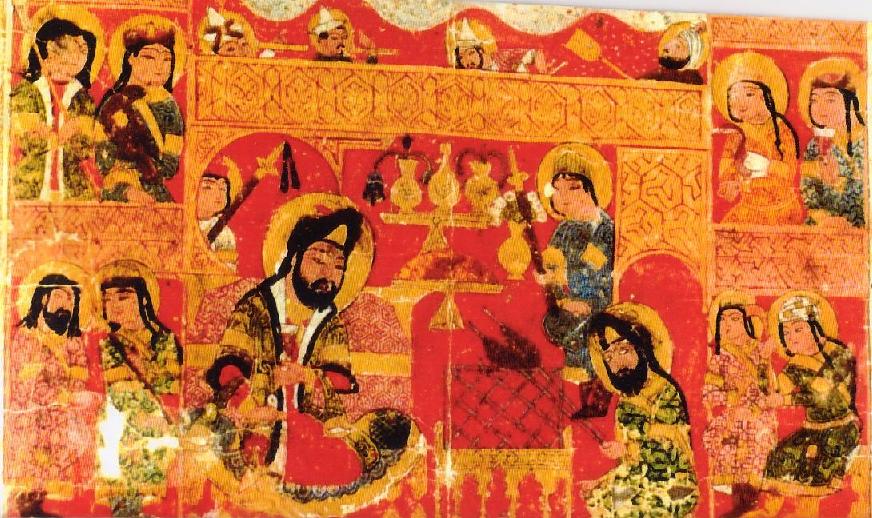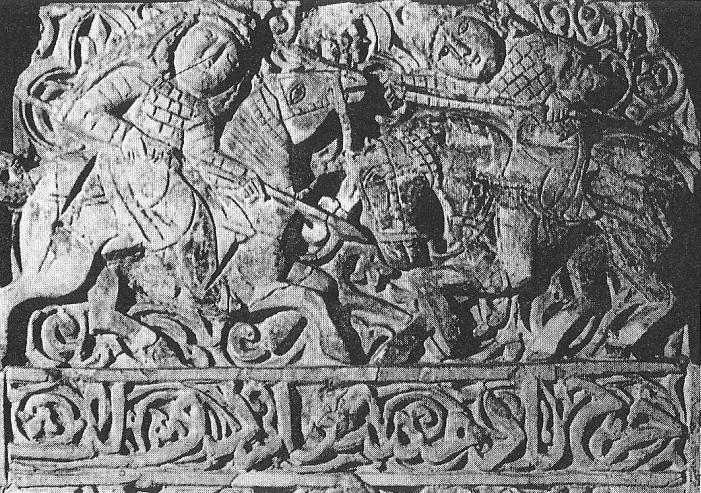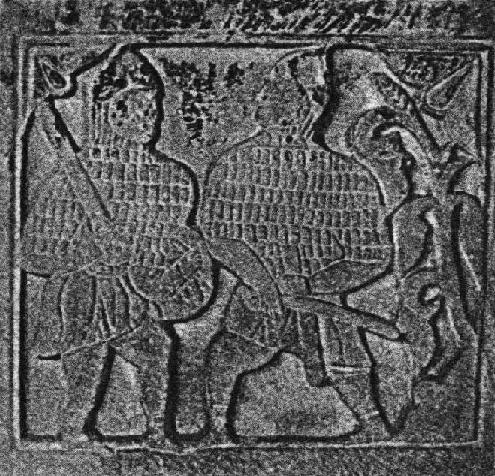The Seljuqs of Rum
by Steven Lowe and Martin Baker
The Seljuqs were among 24 Turkish tribes known as the Oghuz or Ghuzz, originally from Western Siberia. They are thought to have been descended from the Hung-Nu (a Turkish tribe from the region west of China). They originally worshipped the elements, but were converted to Islam in the mid-tenth century AD.
Their founder, Seljuq, was the son of a Turkish commander in the Khazar army. In the late 900’s, Seljuq’s branch of the Ghuzz took service with the Sama’nid Arabs in present-day Turkestan. Shortly afterwards, Turkish commanders of the Sama’nid army rebelled, and allied with the Qara Khans, invaded the region across the Oxus River.
They expanded westward from 1025 to 1029, but Mahmood of Ghazna repulsed them, capturing Seljuq’s son Arslan ibn Seljuq. The Ghuzz scattered to Western Persia and north to Azerbaijan, and Arslan’s nephews Tughril Beg and Daood assumed the leadership. In 1039 Tughril Beg defeated Mahmood’s son Masood, capturing the western territories of the Ghaznavid Kingdom, and leaving Persia open to conquest.
Between 1040 and 1042 the Ghuzz under Tughril Beg expanded south and west, but the same year the Arabs defeated a Ghuzz army in northern Iraq, temporarily checking their advance. Tughril Beg’s half-brother, Ibraham Inal, attacked the Muslim lands north-east of the Tigris, and invaded Armenia. In 1050 Ispahan came under their control, followed by Azerbaijan in 1054.

A Seljuq hunting scene, from Kitab al Diryaq (the Book of Antidotes) by Pseudo-Gallen, probably from Iraq, mid 13th century. National Bibliothek, Vienna.
The Khalif Qaim (who was held virtual prisoner by Malik al Raheem), had inserted Tughril Beg’s name in public prayers, and in 1055 invited Tughril Beg to Baghdad. Soon after Tughril’s arrival trouble started and the Ghuzz ended up taking control of the city. In March 1056 the Khalif married the daughter of Daood, who was now ruler of Khurasan. The following year Qaim named Tughril Beg Sovereign of the East and West.
When in December Tughril left for Hamadan, Basaseeri captured Baghdad in the name of the Fatamid Khalif Mustansir. Tughril Beg’s army had already gone home with the spoils looted from Iraq, and he appealed to his brother Daood for help. Daood died before the message arrived, but his son Alp Arslan arrived with an army. Before he could deal with Basaseeri, he was forced to fight a battle with Tughril’s half brother Ibrahim Inal. Tughril then marched on Baghdad, entering the city in early January 1060. Basaseeri fled upon hearing of the Sultan’s approach, and was killed in an engagement on the Euphrates. In August 1062 Tughril married the daughter of Khalif Qaim, by proxy. In January 1063 he came to Baghdad to see his bride. He then returned to Rei, where he died in August. He had no children.
Alp Arslan was named as Tughril Beg’s successor. If accounts are to be believed, he was tall, strong, brave, cultured, unspoilt, noble, chivalrous, courteous and a magnificent archer. But like his uncle he could neither read nor write. His brother Qutlumish refused to swear allegiance and marched on Rei, but was defeated and killed in December 1063. Early in the next year Alp Arslan was inaugurated as Sultan by Khalif Qaim in Baghdad, and his name was inserted in public prayers.
On the Byzantine Emperor Constantine’s death in 1067, his widow married the distinguished general Romanos Diogenes, who ousted Constantine’s young son Michael VII to become Emperor Romanos IV. He decided to evict the Seljuqs from Armenia, but could only raise a hotchpotch mercenary army, which he commanded in person. In 1068 Romanos marched to Cappadocia and took Menbij, northeast of Aleppo.
At the battle of Manzikert, on August 19th 1071, the Byzantine army was routed and Romanos captured. Alp Arslan imposed peace terms and set Romanos free to return to Byzantium. But Romanos was captured and blinded by his stepson, the Emperor Michael Ducas VII. Romanos died within days. Alp Arslan was also dead within a year, stabbed to death by a captive brought before him for questioning. After Alp Arslan’s death the Seljuq of Rum (their name for Asia Minor, a corruption of “Rome”) became effectively independent of the “Great Seljuq” of Persia.

A Seljuq court, from Kitab al Diryaq (the Book of Antidotes) by Pseudo-Gallen, probably from Iraq, mid 13th century. National Bibliothek, Vienna.
In 1072, the Byzantine Emperor appealed for help from Sulaiman ibn Qutlumish (the son of Qutlumish who had rebelled against Alp Arslan). The Norman mercenary Roussel de Bailleul had rebelled and set up an independent principality in Byzantine territory. Roussel was defeated outside the walls of Constantinople by the combined armies, but the Turks had now achieved a foothold in Asia Minor. Later Byzantine rebels Nikephoros Botaniates and Nikephoros Melissenos raised Turcoman forces and led them to the Bosphoros, where they firmly established themselves. By using Turkish armies to decide dynastic squabbles, Byzantium allowed internal disputes to override the safety of the realm, and lost Asia Minor by default.
Sulaiman ibn Qutlumish established his capital in Nicea, only sixty miles from Constantinople. In 1084 he seized Antioch, which had been held by the Byzantines since 969 AD, and in 1086 he marched on Aleppo. The Arab prince of Aleppo asked King Tutush of Damascus for help. In a battle outside Aleppo Tutush was victorious, Sulaiman stabbing himself with his own dagger. Kilic Arslan, his son, was taken prisoner and held in Ispahan.
During a civil war in 1092, Kilic Arslan, aged 13, escaped. He then broke with the rest of the family, regained most of his father’s kingdom by the time he was seventeen and finally declared himself “Sultan of the Rum”.
In 1095 a civil war was raging between two of Malik Shah’s sons. Byzantine Emperor Alexios Komnenos took advantage of the instability in the Seljuq realm and sent to Pope Urban II appealing for mercenaries to help him regain Asia Minor. Instead, at the Council of Clermont, the Pope preached a Crusade to capture Jerusalem, and Christians throughout Europe flocked to the banner. In 1096 a mainly peasant army under Peter the Hermit and the French knight Walter Sans-avoir (without worldly goods), arrived in Constantinople. They were transported across the Bosphoros and accommodated at Cibotus opposite the City. After some raiding on both sides the People’s Crusade moved out of camp on the 21st of October 1096 to attack the heathen Turks. The resulting ambush left possibly as many as 20,000 Crusaders dead, and their children were sold into slavery. Only 3000 survivors were picked up by Byzantine ships.

A stone carving depicting Seljuq cavalry.
In December the same year, the First Crusade arrived in Constantinople. There was little interest among the Seljuq of Persia in what was happening in Asia Minor, and Kilic Arslan was busy attacking his eastern neighbour Danismend “the Wise”. While he was away, the combined Byzantine and Crusader army took his capital of Nicea and captured the Sultana. (The Emperor later restored her to him). Kilic Arslan immediately repaired relations with the Danismend and together on 1 July 1097 they attacked the Crusaders at Dorylaeum. But they were crushingly defeated, enabling the Crusaders to continue southward and conquer the Holy Land.
Kilic Arslan returned to Asia Minor and made himself master of all Anatolia. In September 1101 he completely destroyed three Crusader armies marching south to reinforce Outremer. He went on to set up a stable economy with elaborate social services, and brought renewed prosperity to Asia Minor. After a brilliant military career, Kilic Arslan was drowned at the battle of Mosul in 1107. Both the Byzantines and the Seljuqs of Persia breathed a sigh of relief.

Armoured Seljuq infantry - Museum of Turkish and Islamic Art, Istanbul.
His son, Mesud, developed bonds with Byzantium, further strengthened his kingdom and destroyed Crusader armies under Conrad II in 1147 and Louis VII of France in 1148. Mesud’s son Kilic Arslan II, in reprisal for devastating attacks by the Danismend, invaded and annexed their principality, and in 1175 he exterminated their dynasty. In September the following year he wiped out an invading Byzantine army at the battle of Myriokephalon. Kilic Arslan II died in 1189, and civil war ensued over the succession.
In 1204 Giyas-al-Din Kai-Khusrau, a noble who had been exiled in Byzantium and had taken a Greek wife, became Sultan. In the same year Byzantium fell to the Fourth Crusade. In 1207 Kai-Khusrau captured the Mediterranean port of Antalya, giving Seljuq trade a new outlet and greatly boosting the economy. In 1210 he attacked Nicea, the capital of the Byzantine Emperor-in-exile Theodore Lascaris. During the battle the Greeks were worsted, but the Turks turned to looting, enabling a Christian to kill Kai-Khusrau and turning the victory into defeat.
Kai-Khusrau’s son, Kai-Qavus, overcame early invasions to strengthen the realm and increase its stability and prosperity. He was succeeded in 1219 by his brother Kai-Qubad I, the greatest ruler of his dynasty. He promoted trade, turned much of Anatolia into a market garden, developed industry (including sugar refineries) and built an enormous naval base at Kalonoros. By the time of his death (poisoned by his son Kai-Khusrau II in 1235/6) he controlled almost all of Asia Minor.

A Seljuq caravan, from Kitab al Diryaq (the Book of Antidotes) by Pseudo-Gallen, probably from Iraq, mid 13th century. National Bibliothek, Vienna.
Kai-Khusrau II has been described as a light-hearted lover of wine and poetry. It was in his reign that the Mongols first invaded the region, overrunning Persia and capturing Baghdad. In 1242 a Mongol invasion caused the collapse of the Seljuq empire. Kai-Khusrau was strangled by his own nobles, and the Mongol ruler Hulagu placed Kai-Khusrau’s three sons jointly on the throne. The three sons conspired against each other and against the Mongols. The last brother, Izz-Al-Din, died in 1264, and was succeeded by his two-year-old son Kai-Khusrau III.
Local rulers splintered off what little power the Sultan had, but he was loyally supported by one of his nobles named Osman, who added Byzantine territory to the empire. Kai-Khusrau gave Osman the title Uc Beg (Protector of the Border). From Kai-Khusrau’s death in 1283 the Sultanate was wracked by civil war, and vanished shortly after 1308. When the Mongol Empire crumbled, it was the descendants of Osman, the Osmanli or Ottomans, who led a resurgent Turkish race to the domination of the Middle East, Constantinople and Eastern Europe.
References
Glubb, John Bagot. The Course of Empire (The Arabs and their Successors).
Hallam, Elizabeth. Chronicles of the Crusades.
Maalouf, Amin. The Crusades Through Arab Eyes.
Platt, Colin. The Atlas of Mediaeval Man.
Talbot-Rice, Tamara. The Seljuks.
The Cambridge History of Iran, Vol. 5: The Saljuq and Mongol Periods.
For a really outstanding page on the steppe tribes, see Qilich's page.
This page was last updated on the 3 May 2002Copyright © Steven Lowe 2001 - 2002
stevenlo@bigpond.net.au